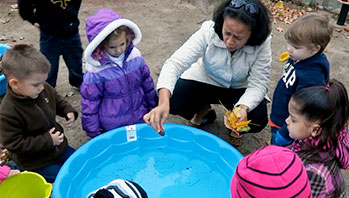- box drums
- clipboards
- crayons or markers
- play instruments
- real instruments
- recorder
- rubber band guitars
- tubes
- tubing
- loud
- quiet
- sound
- source
MA Standards:
Speaking and Listening: SL.PK.MA.1 Participate in collaborative conversations with diverse partners during daily routines and play.
MA Draft Standards:
Physical Sciences/Energy and PS4.B Apply their understanding in their play of how to change volume and pitch of some sounds.
Head Start Outcomes:
Logic and Reasoning/Reasoning and Problem Solving Recognizes cause and effect relationships.
PreK Learning Guidelines:
English Language Arts/Language 2 Participate actively in discussions, listen to the ideas of others, and ask and answer relevant questions.
Explore Together (outdoors): Imitate Outdoor Sounds

© Commonwealth of Massachusetts, Department of Early Education and Care. All rights reserved.
STEM Key Concepts: Different objects make different sounds; Sounds have a source; Sounds vary in three ways: by volume (loud or soft), pitch (high or low), and timbre (quality)
ELA Focus Skills: Speaking and Listening, Vocabulary
Educator Prep: Before gathering children you may want to put the materials in a box so you can transport them outside and back inside.
Tell children they are going to go for another listening walk. Ask questions such as,
- What can you recall about the listening walk we took a few weeks ago? What were some of the bird sounds you heard? What were some of the car sounds you heard?
- Were the sounds loud or quiet?
- How did you find the source of the sound, or where the sound was coming from?
Help children recall their explorations by replaying recordings from the previous walks.
Gather children outside in a circle and ask them to listen quietly to the sounds. After a few minutes, ask, What sounds do you hear? Do you remember any of these sounds from our last listening walk? Can you describe one of the sounds you heard? Encourage children to talk about the sounds using their new sound vocabulary, as well as made-up descriptive words (loud, quiet, soft, high, low, squeaky, scratchy, booming, etc.)
As children explore, encourage them to tape or video record what sounds they hear, or have them dictate to you what they hear and write it down for them to help record their observations. Prompt children to ask for help if they need it.
Reflect and Share
Once you are indoors, play back some of the sounds children recorded. Have children discuss the sound and how they tried to imitate it using their voices. Ask, What kind of sound is this? Who made it? What kind of sound were you trying to imitate?
